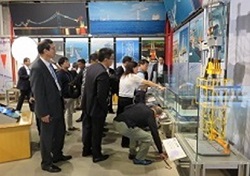IAC News
IAC News No.37, November 2015
Society of Civil Engineers International Activities Center Nov. 2, 2015 IAC News No.37
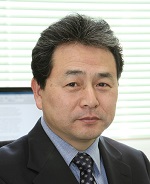
Prof.Norimitsu MIZUTANI(Nagoya University)
Chair of the Committee on Structural Engineering
Recent Activities of the Committee on Civil Engineering in the Ocean, Japan Society of Civil Engineers
The Committee on Civil Engineering in the Ocean (CCEO) was established in 1970 to conduct research and studies related to ocean development and conservation, and to utilize the outcomes for society. Since its foundation, the committee has been emphasizing to work closely with industry to pursue innovations from scientific, technological and on-site perspectives. As part of our activities, we hold the CCEO Annual Symposium for latest research presentations and discussions on ocean development, accompanied by the special sessions focusing on important subjects. The two special sessions held in this year are summarized below.
◆ Special Session 1: Offshore Wind Power Utilization
The pilot researches on offshore wind power generation conducted in coastal areas in Japan were reported in the last year’s special session. Based on the progress of this research field over the last couple of years, this year’s session dealt with techniques for the success of offshore wind farm projects. Presentations were delivered on three themes:
・A case study and proposal for consensus building on an offshore wind project
・Future view of wind power utilization and smart energy system in ports
・Utilization of international certification scheme in Japanese offshore wind farm
These presentations were made based on pilot tests, followed by a lively panel discussion. In recent years, there have been an increasing number of presentations related to ocean energy in the CCEO symposiums. The development and utilization of ocean energy are expected to remain a major theme for the Committee on Civil Engineering in the Ocean.
◆Special Session 2: Storm Surge Disaster
Large-scale coastal disasters have occurred in many parts of the world in recent years, and there is a great concern that these disasters could 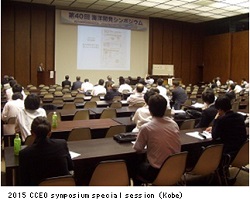 increase both in frequency and magnitude as global warming progresses. In this session, which focused on the prevention and mitigation of coastal disasters such as storm surges amid global warming, the information and technologies accumulated so far were reviewed and the tasks to be addressed were identified and examined. Presentations were delivered on three themes:
increase both in frequency and magnitude as global warming progresses. In this session, which focused on the prevention and mitigation of coastal disasters such as storm surges amid global warming, the information and technologies accumulated so far were reviewed and the tasks to be addressed were identified and examined. Presentations were delivered on three themes:
・Development of new GPS ocean wave meter and demonstration experiments for hydrographic phenomenon in the offshore
・Study on the characteristics of future typhoons based on the climate projection data MRI-AGCM3.2S
・Field survey and mechanism of storm surge generation invoked by the low pressure with rapid development in Nemuro, Hokkaido in December 2014
In addition to tsunami-related researches that have substantially increased in number since the 2011 Great East Japan Earthquake and Tsunami, we look forward to seeing many such researches on storm surges, which are expected to be presented in the CCEO Annual Symposium in the coming years.
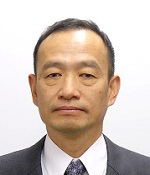
Airou Asayama
(Taisei Cooperation)
Hushan Reservoir Project
Hushan Dam is located in Yunlin County, Taiwan, about 60 km north of Wushantou Dam, which was constructed by the engineer Yoichi Hatta. It is located on a tributary with a small catchment area, the same as for the Wushantou Dam, and is an earthfill dam that stores water fed from the main stream of the river. The stored water supplies the Yunlin and Nantou Counties with about 261,000 m3 of water per day, and it is expected to reduce the ground settlement in these counties due to pumping-up of groundwater.
The dam consists of 3 connected units, with a total storage of 15.1 million m3 and a total length of 1,521 m, making it the largest in Taiwan.
The client for the project was the Central Region Water Resources Office, Water Resources Agency, Ministry of Economic Affairs of the Republic of China, and construction of the dam was undertaken by a joint venture of Taisei Corporation and Continental Engineering Corporation, Taiwan’s largest general contractor.
The contract period was from June 2007 to September 2014, but the project was completed 2 months ahead of schedule. At present other contract work such as water intake construction is in progress.
|
Picture-1:Overall view of building the embankment for Hushan Dam |
Picture-2:Construction of the continuous diaphragm wall on the left bank of a subsidiary dam |
The dam foundation of Hushan Dam and the strata beneath the reservoir are alternating strata of the Quaternary sedimentary rocks sandstone and mudstone. The shell material and core material were obtained within the dam site, and high viscosity clay for the rock adherent core material, filter material, and rip rap material, etc., were transported from outside the site. Features of the foundation design are the adoption of a diaphragm wall using plastic concrete instead of curtain grouting, and omitting blanket grouting. Also, the inspection gallery was omitted. Note that the top of the diaphragm wall was designed to be enclosed by the core, to ensure continuity of the waterproofing.
The diaphragm wall extended continuously over the 3 dams with a total length of about 2.3 km, a width of 1 m, and a maximum depth of 55 m. Construction of the diaphragm wall through the dam abutment slope was very difficult, but was achieved by constructing a temporary platform on which the heavy equipment for the diaphragm wall could operate. The earthwork was on a scale rarely seen in Taiwan, so a construction system was composed with large-sized heavy equipment procured from outside Taiwan.
Construction was completed with zero major accidents, and high evaluation was obtained from the client for not only schedule and safety, but also quality and environmental initiatives. As a result the project was awarded the highest award for public works in Taiwan, the “Public Construction Golden Quality Award.”
As a result of the efforts of our predecessors a “Japanese” brand has been established in Taiwan, and we can take pride that this brand name has not been tarnished by this work.
|
Picture-3:Construction of the continuous diaphragm wall on the left bank of the main dam |
Picture-4:Aerial photograph after completion of Hushan Dam |
Brief Summary on 2015 JSCE Annual Meeting - International Program
2015 JSCE Annual Meeting was held at Okayama University Tsushima Campus from September 16th to 18th, 2015. During which, the international program hosted by IAC was held for the first two days. Its details are will be reported on another issue of IAC News.
| ◆IAC Special Discussion (September 16, 10:20-12:20) Prof. Masahiro Ouchi, Kochi University of Technology organized and moderated the discussion. Ten participants from young to senior who have studied in Japan discussed their experiences and made frank and straightforward requests for the civil engineering industry in Japan. They emphasized that Japanese young engineers, who should be aware of their responsibilities as professional engineers, need to go overseas more actively. |
|
|
◆International Roundtable Meeting (September 16, 13:30-17:00) International Roundtable Meeting was held under the theme “Leveraging Big Data for Infrastructure Management and Sustainable Development” proposed by Mr. Noriaki Hirose, the JSCE President. Prof. Toshio Koike (Director, ICHARM) served as a moderator and Prof. Masaru Kitsuregawa (Director General, National Institute of Informatics) delivered a keynote speech titled “How IT(Big Data) can transform our society?” Following the speech, participants from JSCE International Sections and JSCE’s Agreement of Cooperation (AOC) societies discussed the current status of Big Data utilization and future challenges. |
|
| ◆The Seventeenth International Summer Symposium (September 16, 17, 9:00-12:00) 56 papers were presented by young engineers and international students, including 5 papers by the participants on a Study Tour Grant, which was carried out by the support from International Scientific Exchange Fund. There were many international students in the hall. We hope more Japanese students will participate in the future. |
|
| ◆Workshop for Young Engineers (September 16, 13:30-17:00) Workshop for Young Engineers, which has started as one of the commemorative events for JSCE’s 100th Anniversary, was held this year, too. On the theme of “Why did you come to Japan? –expectation, reality and future.” 24 current international students in Japan made a group discussion and delivered presentations. |
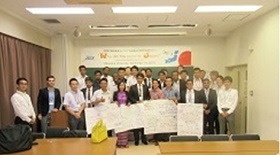 Participants at the workshop |
|
◆Technical Tour (September 17, 11:00-16:30) |
International guests listening to |
In addition, the IAC had International Section Meeting with International Sections and exchanged opinions. Separately from the banquet offered by the JSCE Annual Meeting steering committee, we held the welcome reception for international guests and international students at the tower of Okayama Castle with the cooperation of Okayama Visitors and Convention Association, and participants deepened their friendship with each other.
【Written by International Activities Center】
JSCE-UK SectionVisit Report
On 28 August 2015 I visited Prof. Kenichi Soga (University of Cambridge), President of the UK Section, and exchanged information. At present the UK Section has about 10 Japanese members.
1) Report on the Status of Japan Society of Civil Engineers
I reported on the success of the JSCE 100th anniversary project, and on recent matters using relevant documents. The society has 35,000 members, and 5,000 student members. Membership is stable and financial administration has improved, but income from publications has declined. With the establishment of the JSCE International Activities Center, International Sections are being strengthened, overseas students are being organized, and efforts have been made to activate the Asian Civil Engineering Coordinating Council (ACECC).The next policies of JSCE will have an emphasis on the national stock of infrastructure, and will also focus on maintenance and sustainability.
| 2) Status of the UK Construction Industry (by Prof. Soga, President of the Section) The Department for Business, Innovation & Skills has stated that the domestic construction industry has shrunk by 33%, and has established a policy that half of its turnover should come from overseas. Also, the trend for young people in the UK to be uninterested in engineering continues. In contrast the UK, Institution of Civil Engineers (ICE) has initiated efforts towards a new target. |
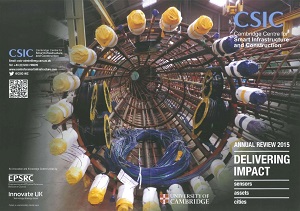 Information on Cambridge Centre for Smart Infrastructure and Construction |
The Department of Civil Engineering of University of Cambridge has founded the “Cambridge Centre for Smart Infrastructure and Construction” (CSIC), dealing with information technology in infrastructure, and improving productivity by cooperation among each field, and integration.
Here “smart” is a concept with a broad meaning, and the UK has a culture of setting abstract targets such as this and working towards them. Note that Professor Yozo Fujino of Yokohama National University, Japan has been appointed as a member of CSIC’s International Advisory Group.
3) Author’s Comments
The turnover of the Japanese construction industry is also about half that during the peak of 1998, and although it has recovered somewhat due to reconstruction of the 2011 Great East Japan Earthquake and Tsunami, recurring profit margins are only 5% or less. The Government’s “Basic Policy on National Budget” calls for improvement in productivity of industry, but does not touch on enhancement of infrastructure which is its basis.
【Yumio Ishii, Former President of JSCE】
What's Happening
- 2015/11/19-21
PICE 41st National Convention (SMX Convention Center, Bacolod City, Philippines)
- 2015/11/20-21
CICHE 2015 Annual Conference (National Taiwan University, Taipei, Taiwan)
Updates
- The summary of feature articles in the JSCE Magazine is available on the JSCE website.
http://www.jsce-int.org/pub/magazine - Concrete Committee International Newsletter No. 42
http://www.jsce.or.jp/committee/concrete/e/newsletter/Newsletter.htm - Journal of JSCE
The Journal of JSCE is the collection of research papers which can be viewed on the JSCE website.
https://www.jstage.jst.go.jp/browse/journalofjsce - Disaster Fact Sheet
http://committees.jsce.or.jp/disaster/ - IAC Students and Alumni Network
http://www.jsce-int.org/IAC_network/registration
IAC News Subscription
The IAC News is one of the communication tools to share information and ideas with the members. We would like to invite you, your friends and colleagues to join the communication and to subscribe the IAC News. Please register online: (http://www.jsce-int.org/node/150). We look forward to meeting you.
Editor's postscript
ISO 14001, which is an international standard related to environmental management, was revised radically and issued as a new standard on September 16, 2015. The new standard incorporates new key words such as "biodiversity" and "ecosystem." The standard also includes the keyword "life cycle assessment" with the purpose of assessing environmental impact throughout the life cycle of product and business activities. Companies’ qualities and values are assessed by not only their efforts to deal with climate change, but also the ones to build comprehensive environmental management systems including life cycle assessment and biodiversity. I would like to follow how each company deals with these challenges in the future. (H.I.)

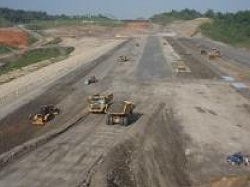
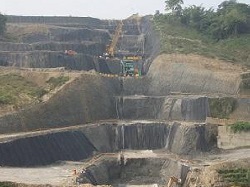
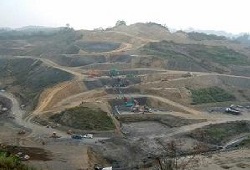
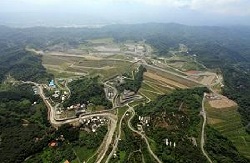
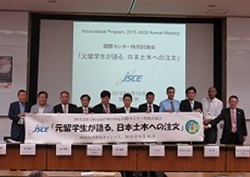 Participants at the discussion
Participants at the discussion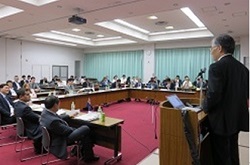 International Roundtable Meeting
International Roundtable Meeting